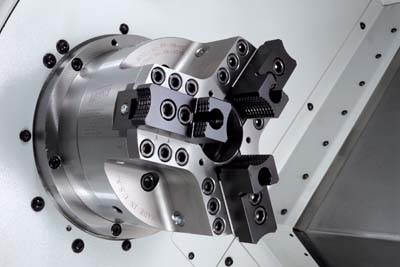
Hardinge Inc. manufactures a premiere line of lever-operated, counter-centrifugal and dynamically balanced Sure-Grip Power Chucks. The lever-operated design of the Hardinge chuck has several advantages over the wedge-type design most commonly found on low cost, non-counterbalanced chucks that are supplied with the initial purchase of many chuck-style lathes.
In the Hardinge lever-operated system, the drawtube is connected to the jaws through a pivoting lever that is mounted on pins inside the chuck body. The lever system has reduced friction and increased mechanical advantage compared to a wedge-operated chuck for a given draw bar pressure. In other words, a lever will always have greater actual gripping power at the jaws than a wedge-operated chuck, for any given draw bar pressure.
The lever system also has reduced internal bearing surface over the wedge-operated closure, making it less sensitive to lack of lubrication. The greater efficiency of the design results in reduced wear on the operating cylinder, dramatically increasing component life. For this reason, a lever-operated chuck system (chuck and operating cylinder) will usually have a longer life than that of a wedge-operated system.
In the Hardinge counterbalanced chuck design, weights are incorporated into the actuating levers of the chucks at the opposite end of the fulcrum or pivot-point of the jaws. Centrifugal force acts upon this weight just as it does on the top jaws. However, since the weight is at the opposite side of the lever from the top jaws, the upward thrust generated counteracts some of the jaw force loss. Thus, the counterbalanced lever design has substantially more gripping force at high RPM than that of a non-counterbalanced style.
The major advantage of the Sure-Grip power chuck is the configuration of the drawtube that actuates the chuck. Since Hardinge machines all have collet spindles that do not require a collet chuck or adaptor, it is a simple matter to remove the collet and quickly mount the 3-jaw Sure-Grip power chuck when needed. The chuck's drawtube threads directly into the machine's draw bar, just as a collet would. This changeover can be accomplished in ten minutes or less. Other designs can take hours. The Sure-Grip power chuck is also available for non-Hardinge lathes that do not have collet style spindles.
Hardinge manufactures its chuck components to high accuracy and repeatability standards. The repeatability of a chuck is the measure of its ability to repeat the performance, either from job-to-job or from part-to-part. Most models of Hardinge Sure-Grip power chucks have an accuracy (T.I.R.) of .0005 inch and repeatability of .0005 inch, making them ideal for close tolerance turning requirements. Hardinge Sure-Grip power chucks are competitively priced, while demonstrating distinct advantages over the wedge style chuck.
Contact Details
Related Glossary Terms
- chuck
chuck
Workholding device that affixes to a mill, lathe or drill-press spindle. It holds a tool or workpiece by one end, allowing it to be rotated. May also be fitted to the machine table to hold a workpiece. Two or more adjustable jaws actually hold the tool or part. May be actuated manually, pneumatically, hydraulically or electrically. See collet.
- collet
collet
Flexible-sided device that secures a tool or workpiece. Similar in function to a chuck, but can accommodate only a narrow size range. Typically provides greater gripping force and precision than a chuck. See chuck.
- tolerance
tolerance
Minimum and maximum amount a workpiece dimension is allowed to vary from a set standard and still be acceptable.
- turning
turning
Workpiece is held in a chuck, mounted on a face plate or secured between centers and rotated while a cutting tool, normally a single-point tool, is fed into it along its periphery or across its end or face. Takes the form of straight turning (cutting along the periphery of the workpiece); taper turning (creating a taper); step turning (turning different-size diameters on the same work); chamfering (beveling an edge or shoulder); facing (cutting on an end); turning threads (usually external but can be internal); roughing (high-volume metal removal); and finishing (final light cuts). Performed on lathes, turning centers, chucking machines, automatic screw machines and similar machines.

